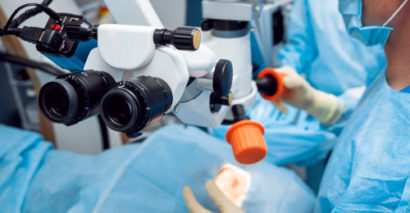According to the most recent estimates, the average pocket cost of cataract surgery is $ 3,500 per eye. This price reflects the procedure of conventional cataract surgery that is not covered by private insurance or Medicare, which would compensate for out-of-pocket expenses.
The vast majority of people in the United States who have cataracts are over 65 and therefore covered by Medicare. Those who are not eligible for Medicare but need surgery usually have some type of private insurance coverage, the scope of which varies by plan.
The technologies and techniques used also affect the cost. Laser cataract surgery is becoming a popular alternative to traditional cataract surgery, and can cost more than $ 1,000 per eye, above the base rate.

The type of intraocular lens (IOL) also influences the cost. There are two basic categories of premium intraocular lenses: toric to correct astigmatism and refractive (Crystalens, ReSTOR, ReZoom, Tecnis) to correct presbyopia. The additional cost of cataract surgery with toric intraocular lenses is approximately $ 1,300. Refractive intraocular lenses are even more expensive, with an average cost of $ 2,100. Therefore, if you choose to have cataract surgery with premium refractive IOLs, in theory the cost would be around $ 5,600.
These high-tech lenses are different from the traditional monofocal IOLs used in basic cataract surgery, which corrects vision for only one distance, but does not correct astigmatism.
What factors impact the cost?
Although estimates can give you an idea of the price of cataract surgery, the exact cost of your surgery may differ substantially depending on several factors, such as:
- The area of the country where the surgery is performed.
- If the surgery is performed in an outpatient surgical center or hospital.
- The skill, reputation and experience of the surgeon.
- The type of intraocular lens you choose.
- Whether or not a laser is used.
- Pre and postoperative consultations.
- Postoperative medications.
These factors may affect the written cost of cataract surgery, but the biggest factor that impacts the actual cost is the type of insurance coverage you have.
Private insurance coverage and Medicare
Because cataract surgery is considered a medically necessary procedure, its cost is largely covered by private insurance or Medicare, and the latter covers most patients. Medicare is the United States federal health insurance program that offers coverage to adults over 65. Although Medicare Part A is free for most, Part B has a monthly premium (usually between $ 100 and $ 135).
Cataract surgery is usually an outpatient procedure, which means that you have surgery in a hospital or doctor’s office and then return home the same day. As such, it is included in Medicare Part B (which covers medical services and outpatient treatments).
Although Medicare and private insurance generally cover conventional cataract surgery with monofocal implants, they do not cover the additional cost of refractive cataract surgery, which includes premium intraocular lenses and / or a laser. Medicare covers approximately 80% of the cost associated with conventional cataract surgery, with the patient being responsible for the remaining 20% after the deductible (the 2017 deductible for Medicare Part B was $ 183). Below is a table as an example of what a conventional Medicare-covered cataract surgery would cost:
| Conventional Cataract Surgery | CoverageMedicare | Pocket payment | Deductible | Total cost for the patient |
|---|---|---|---|---|
| $ 3,500 | $ 2,800 | $ 700 | $ 183 | $ 883 |
For conventional cataract surgery, Medicare covers:
- The cataract extraction.
- Basic lens implants (monofocal).
- A pair of prescription glasses or a pair of contact lenses after surgery.
If the patient wants premium intraocular lenses to correct refractive errors and eliminate dependence on glasses and contact lenses, he must take care of the difference. For example, if the patient referred to in the previous price breakdown would like to have surgery with a premium toric intraocular lens to correct astigmatism, he will have to pay $ 883 + $ 1,300 ($ 2,183), which is the average cost of the intraocular lens toric If the patient opted for the intraocular lens that corrects presbyopia, the cost would be $ 883 + $ 2,100 ($ 2,983). If you also want laser cataract surgery, you must add another $ 1,000. Basically, premium cataract surgery can almost double or triple the potential out-of-pocket costs.
Medigap Supplementary Insurance
If you want to have premium cataract surgery but are concerned about out-of-pocket expenses that are not covered by Medicare, there is the possibility of buying a separate policy called “Medigap” from private insurance companies. Medigap plans complement Medicare coverage and help offset out-of-pocket costs for medical care. They work very similar to traditional insurance policies but on a much more limited scale. It means they have their own deductible that must be achieved before the coverage is applied.
Schedule a consultation
The best way to determine what cataract surgery will cost you is to schedule a consultation with a surgeon to discuss treatment options. The surgeon can offer you a budget based on your unique considerations. You can also talk to your insurance company for specific details about your policy coverage. Medicare patients can visit the Medicare.gov website for more information or contact the organization at 1-800-MEDICARE to speak with a customer service representative.